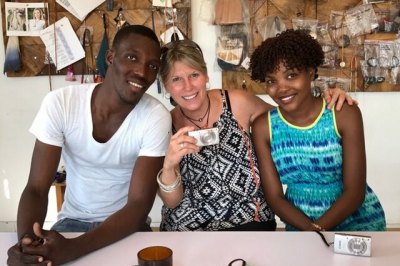Through Her Lens: Exploring Haiti’s Craft Scene with Alison Wright

Left photo credit: Alison Wright
Award-winning National Geographic contributing photographer, Alison Wright, has just returned from Haiti. And fortunately for us, her experience has not gone undocumented. This week, in addition to gearing up for our week-long August takeover of Alison’s stunning photographs on Nest’s Instagram, we are speaking with her on the Nest Journal about the intersection of craft and culture, as she experienced it on her recent trip.
Nest: What was your first encounter with Haiti? How did your most recent trip to the country compare? How have things changed or remained the same?
I spent about a month there after the earthquake, documenting the chaos and devastation that rocked the country and killed about 300,000 people. A family was kind enough to let me sleep in their yard and never once did they ask when I was leaving. Shortly after I had returned to the States, I was sent back to Haiti to shoot a Smithsonian Magazine feature story on all of the beautiful Haitian art that had been destroyed. The experience provided an enlightening education in the artistic beauty of the culture while also overwhelming me with its sadness.
This past trip for Nest was my first time back to Haiti since the Smithsonian project. It was disheartening to see much of Port-au-Prince still steeped in rubble. I commiserated with the anger and frustration Haiti’s people are feeling in response to the lack of infrastructure that has reached them. While Americans gave to the bone to help, political corruption continues to run rampant in the country, unfortunately. The cholera epidemics and hurricanes aren’t helping: Haiti keeps getting slammed.
Nest: What types of craftsmanship did you see taking place in Haiti? Which type of technique made the greatest impression on you and why?
The craft I saw ranged from factory-type production with a strong focus on ensuring fair wages to women, to an enterprise through which women made their own jewelry from horn and leather tanning. In all cases, I was impressed by the innovation and dedication that these women brought to their work. You could directly witness the empowerment through financial freedom and personal creativity these women were experiencing.
Nest: What struck you about the women you met? How were their personal stories reflected in their craftwork?
Magalie, who founded Caribbean Craft, had so much energy and enthusiasm that I could barely convince her to sit still for a photo. A sweet older women who worked at the factory making paper mache products let me know that this job is affording her some financial freedom from her husband: after he knocked out her front teeth, she took her craft earnings to buy new ones.
Nest: As part of your work with Nest, you assisted some of the women you met in utilizing a digital camera to improve their marketing and product photography – you even left a couple of cameras behind for the women. Can you tell us more about what it was like to share your craft of photography with the artisan women you met?
I love sharing my photographic knowledge with other women. These women were so excited to learn something new, and to see the world in a different way. I had a blast using the cameras with the folks at At Haiti Design Company, where Christelle Paul is fulfilling her dream making jewelry from cow horn. She left her last job and opened a workshop in the most dangerous part of downtown Port-au-Prince – the workshop still doesn’t have a roof! I told her that she’s a true badass. Christelle was so excited to learn how to use a camera to take better photos to sell her jewelry on line, so I left the camera with her to continue using.
Nest: As a photographer, what is the lasting image of Haiti that is most impressed upon your mind’s eye?
The generosity of the people and their enduring spirit are what stays with me. When you see how much these people have overcome, you can’t help but be awed by their tenacity, resiliency, and ceaseless creativity.
Tags: Alison wright, Caribbean craft, Craft, Haiti, Haiti design company, Jewelry, National geographic, Nest Guild, Nest Professional Fellowships, Paper mache, Photographer, Port-au-prince, Smithsonian